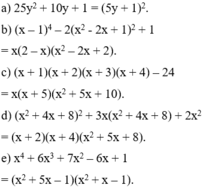( x2 + 4x + 3 )( x2 + 6x +8 ) = 24

Những câu hỏi liên quan
Phân tích đa thức thành nhân tử:a) 25
y
2
+ 10
y
8
+1;b)
(
x
-
1
)
4
-
2
(
x
2
-
2...
Đọc tiếp
Phân tích đa thức thành nhân tử:
a) 25 y 2 + 10 y 8 +1;
b) ( x - 1 ) 4 - 2 ( x 2 - 2 x + 1 ) 2 +1;
c) (x + 1)(x + 2)(x + 3)(x + 4) - 24;
d) ( x 2 + 4 x + 8 ) 2 + 3 x ( x 2 + 4x + 8) + 2 x 2 ;
e) x 4 + 6 x 3 +7 x 2 -6x + 1.
1) (x2-4x+16) (x+4)-x(x+1) (x+2)+3x2=0
2) (8x+2) (1-3x)+(6x-1) (4x-10)=-50
3) (x2+2x+4) (2-x)+x(x-3) (x+4)-x2+24=0
4) (\(\dfrac{x}{2}\)x2+3) (5-6x)+(12x-2) (\(\dfrac{x}{4}\)x4+3)=0
1)(x2-4x+16)(x+4)-x(x+1)(x+2)+3x2=0
\(\Rightarrow\)(x3+64)-x(x2+2x+x+2)+3x2=0
\(\Rightarrow\)x3+64-x3-2x2-x2-2x+3x2=0
\(\Rightarrow\)-2x+64=0
\(\Rightarrow\)-2x=-64
\(\Rightarrow\)x=\(\dfrac{-64}{-2}\)
\(\Rightarrow x=32\)
Đúng 1
Bình luận (0)
2)(8x+2)(1-3x)+(6x-1)(4x-10)=-50
\(\Rightarrow\)8x-24x2+2-6x+24x2-60x-4x+10=50
\(\Rightarrow\)-62x+12=50
\(\Rightarrow\)-62x=50-12
\(\Rightarrow\)-62x=38
\(\Rightarrow\)x=\(-\dfrac{38}{62}=-\dfrac{19}{31}\)
Đúng 1
Bình luận (0)
3)(x2+2x+4)(2-x)+x(x-3)(x+4)-x2+24=0
\(\Rightarrow\)8-x3+x(x2+4x-3x-12)-x2+24=0
\(\Rightarrow\)8-x3+x3+4x2-3x2-12x-x2+21=0
\(\Rightarrow\)-12x+29=0
\(\Rightarrow\)-12x=-29
\(\Rightarrow\)x=\(\dfrac{-29}{-12}=\dfrac{29}{12}\)
Đúng 1
Bình luận (0)
bài 1:phân tích đa thức thành nhân tử
a,x4 +5x2 +9
b,x4 + 3x2 +4
c,2x4 - x2 -1
Bài 2:tìm x biết
a,(x+1) (x+2)(x+3)(x+4)= 120
b,(x-4x+3)(x2+6x +8) +24
Bài 1:
\(a,x^4+5x^2+9\\=(x^4+6x^2+9)-x^2\\=[(x^2)^2+2\cdot x^2\cdot3+3^2]-x^2\\=(x^2+3)^2-x^2\\=(x^2+3-x)(x^2+3+x)\)
\(b,x^4+3x^2+4\\=(x^4+4x^2+4)-x^2\\=[(x^2)^2+2\cdot x^2\cdot2+2^2]-x^2\\=(x^2+2)^2-x^2\\=(x^2+2-x)(x^2+2+x)\)
\(c,2x^4-x^2-1\\=2x^4-2x^2+x^2-1\\=2x^2(x^2-1)+(x^2-1)\\=(x^2-1)(2x^2+1)\\=(x-1)(x+1)(2x^2+1)\)
Đúng 1
Bình luận (2)
Bài 2:
\(a,\left(x+1\right)\left(x+2\right)\left(x+3\right)\left(x+4\right)=120\)
\(\Leftrightarrow\left[\left(x+1\right)\left(x+4\right)\right]\cdot\left[\left(x+2\right)\left(x+3\right)\right]=120\)
\(\Leftrightarrow\left(x^2+5x+4\right)\left(x^2+5x+6\right)=120\) (1)
Đặt \(x^2+5x+5=y\), khi đó (1) trở thành:
\(\left(y-1\right)\left(y+1\right)=120\)
\(\Leftrightarrow y^2-1=120\)
\(\Leftrightarrow y^2=121\)
\(\Leftrightarrow\left[{}\begin{matrix}y=11\\y=-11\end{matrix}\right.\)
+, TH1: \(y=11\Leftrightarrow x^2+5x+5=11\)
\(\Leftrightarrow x^2+5x-6=0\)
\(\Leftrightarrow x^2-x+6x-6=0\)
\(\Leftrightarrow x\left(x-1\right)+6\left(x-1\right)=0\)
\(\Leftrightarrow\left(x-1\right)\left(x+6\right)=0\)
\(\Leftrightarrow\left[{}\begin{matrix}x-1=0\\x+6=0\end{matrix}\right.\Leftrightarrow\left[{}\begin{matrix}x=1\\x=-6\end{matrix}\right.\left(\text{nhận}\right)\)
+, TH2: \(y=-11\Leftrightarrow x^2+5x+5=-11\)
\(\Leftrightarrow x^2+5x+16=0\)
\(\Leftrightarrow\left[x^2+2\cdot x\cdot\dfrac{5}{2}+\left(\dfrac{5}{2}\right)^2\right]-\dfrac{25}{4}+16=0\)
\(\Leftrightarrow\left(x+\dfrac{5}{2}\right)^2+\dfrac{39}{4}=0\)
Ta thấy: \(\left(x+\dfrac{5}{2}\right)^2\ge0\forall x\)
\(\Rightarrow\left(x+\dfrac{5}{2}\right)^2+\dfrac{39}{4}\ge\dfrac{39}{4}>0\forall x\)
Mà \(\left(x+\dfrac{5}{2}\right)^2+\dfrac{39}{4}=0\)
\(\Rightarrow\) loại
Vậy \(x\in\left\{1;-6\right\}\).
\(b,\) Đề thiếu vế phải rồi bạn.
Đúng 1
Bình luận (0)
Giải phương trình:
(x2 - 4x + 3)(x2 - 6x +8) = 3
\(\Leftrightarrow\left(x^2-5x+3\right)\left(x^2-5x+7\right)=0\)
Đúng 0
Bình luận (0)
Cho hàm số
-
x
2
+
4
x
-
3
+
-
x
2
+
6
x
8
. Tập xác định của hàm số là: A.
D
1
;
3
∪
2
;
4...
Đọc tiếp
Cho hàm số - x 2 + 4 x - 3 + - x 2 + 6 x = 8 . Tập xác định của hàm số là:
A. D = 1 ; 3 ∪ 2 ; 4
B. D = - ∞ ; 2 ∪ 3 ; + ∞
C. D = 2 ; 3
D. D = ∅
Bài 3: Rút gọn biểu thức:
a) (6x+1)2+(6x-1)2-2(1+6x)(6x-1); b) 3(22+1)(24+1)(28+1)(216+1); c) x(2x2-3)-x2(5x+1)+x2; d) 3x(x-2)-5x(1-x)-8(x2-3)
giải các bất phương trình sau
a, <x-3>*<x2+x-20>≥0
b, x2-4x-5 /2x+4 ≥0
c, -1/x2-6x+8≤1
a, \(\left(x-3\right)\left(x^2+x-20\right)\ge0\)
\(\Leftrightarrow\) \(\left(x-3\right)\left(x-4\right)\left(x+5\right)\ge0\)
+) \(x-3=0\Leftrightarrow x=3\); \(x-4=0\Leftrightarrow x=4\); \(x+5=0\Leftrightarrow x=-5\)
+) Lập trục xét dấu f(x) (Bạn tự kẻ trục nha)
\(\Rightarrow\) Bpt có tập nghiệm S = \(\left[-5;3\right]\cup\) [4; \(+\infty\))
b, \(\dfrac{x^2-4x-5}{2x+4}\ge0\)
\(\Leftrightarrow\) \(\dfrac{\left(x-5\right)\left(x+1\right)}{2x+4}\ge0\)
+) \(x-5=0\Leftrightarrow x=5\); \(x+1=0\Leftrightarrow x=-1\); \(2x+4=0\Leftrightarrow x=-2\)
+) Lập trục xét dấu f(x)
\(\Rightarrow\) Bpt có tập nghiệm S = (-2; -1] \(\cup\) [5; \(+\infty\))
c, \(\dfrac{-1}{x^2-6x+8}\le1\)
\(\Leftrightarrow\) \(\dfrac{\left(x-3\right)^2}{\left(x-4\right)\left(x-2\right)}\ge0\)
+) \(x-3=0\Leftrightarrow x=3\); \(x-4=0\Leftrightarrow x=4\); \(x-2=0\Leftrightarrow x=2\)
+) Lập trục xét dấu f(x)
\(\Rightarrow\) Bpt có tập nghiệm S = (\(-\infty\); 2) \(\cup\) (4; \(+\infty\))
Chúc bn học tốt!
Đúng 2
Bình luận (0)
Tìm x, biết
b) x2 - 2x + 1 = 4
c) x2 - 4x + 4 = 9
d) 4x2 - 4x + 1 = 4
e) x2 - 2x - 8 = 0
f) 9x2 - 6x - 8 = 0
b)x2-2x+1=4
⇔(x-1)2=4
\(\Leftrightarrow\left[{}\begin{matrix}x-1=2\\x-1=-2\end{matrix}\right.\Leftrightarrow\left[{}\begin{matrix}x=3\\x=-1\end{matrix}\right.\)
c)x2-4x+4=9
⇔ (x-2)2=9
\(\Leftrightarrow\left[{}\begin{matrix}x-2=3\\x-2=-3\end{matrix}\right.\Leftrightarrow\left[{}\begin{matrix}x=5\\x=-1\end{matrix}\right.\)
d)4x2-4x+1=4
⇔ (2x-1)2=4
\(\Leftrightarrow\left[{}\begin{matrix}2x-1=4\\2x-1=-4\end{matrix}\right.\Leftrightarrow\left[{}\begin{matrix}x=\dfrac{5}{2}\\x=\dfrac{-3}{2}\end{matrix}\right.\)
e)x2-2x-8=0
⇔ x2-4x+2x-8=0
⇔ x(x-4)+2(x-4)=0
⇔(x-4)(x+2)=0
\(\Leftrightarrow\left[{}\begin{matrix}x=4\\x=-2\end{matrix}\right.\)
f)9x2-6x-8=0
⇔ 9x2-12x+6x-8=0
⇔ 3x(3x-4)+2(3x-4)=0
⇔ (3x-4)(3x+2)=0
\(\Leftrightarrow\left[{}\begin{matrix}x=\dfrac{4}{3}\\x=\dfrac{-2}{3}\end{matrix}\right.\)
Đúng 1
Bình luận (0)
Phân tích đa thức thành nhân tử:
a) xy + y2 – x – y
b) 25 – x2 + 4xy – 4y2
c) 4x3 + 4xy2 + 8x2y – 16x
d) (x2 + x)2 + 4(x2 + x) – 12
e) (x + 1) (x + 2) (x + 3) (x + 4) - 24 g)
h) x2 – 5x + 4
i) x4 – 5x2 + 4
j) x3 – 2x2 + 6x – 5
k) x2 – 4x + 3
a: \(=x\left(x+y\right)-\left(x+y\right)=\left(x+y\right)\left(x-1\right)\)
b: \(=25-\left(x-2y\right)^2\)
\(=\left(5-x+2y\right)\left(5+x-2y\right)\)
Đúng 3
Bình luận (0)
Tìm x:
√(x2-6x+11) + √(x2-6x+13) + √(x2-4x+5) = 3+√2
√(x2-6x+11) + √(x2-6x+13) + √(x2-4x+5) = 3+√2 (1)
Có: \(\sqrt{x^2-6x+11}=\sqrt{\left(x-3\right)^2+2}\ge\sqrt{2}\)
(Dấu = xảy ra khi x = 3)
\(\sqrt{x^2-6x+13}=\sqrt{\left(x-3\right)^2+4}\ge\sqrt{4}=2\)
(Dấu = xảy ra khi x = 3)
\(\sqrt{x^2-4x+5}=\sqrt{\left(x-2\right)^2+1}\ge1\)
(Dấu = xảy ra khi x = 2)
Nhận xét PT (1):
\(VT\ge3+\sqrt{2}\)
\(VP=3+\sqrt{2}\)
Nên: √(x2-6x+11) + √(x2-6x+13) + √(x2-4x+5) = 3+√2 khi: x = 3 và x = 2
=> PT vô nghiệm
Đúng 2
Bình luận (0)




























